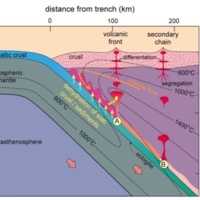Andean Arc Magma Generation
Item
-
Title
-
Andean Arc Magma Generation
-
Description
-
Volcanic arcs like the Andean Arc are formed through subduction zone volcanism. The collision of the oceanic and continental plates causes folding and faulting which thickens the crust, but also, volcanic processes that create the arc. As the subducting slab sinks deeper into the mantle, it reaches a certain depth where the hydrous minerals in the basalt dehydrate. This water is released into the surrounding mantle and lowers the melting temperature, allowing melting to take place. This melt rises to the top of the mantle and slowly breaks through the crust until it is released the form of lava from a volcano. Melt produced at an island arc like the Andean Arc is calc-alkaline in composition. This means that the melt is high in incompatibles as a result of incompatibles from the subducting slab being reintroduced to the mantle.
Picture from:
Winter, J. D. (n.d.). Igneous and Metamorphic Petrology Class Material.
Retrieved May 6, 2015, from https://www.whitman.edu/geology/winter/
JDW_PetClass.htm
-
Creator
-
Claire Kojaian
-
Mediator
-
Tamara Carley
carleyt@lafayette.edu
-
Rights Holder
-
Lafayette College Department of Geology and Environmental Geosciences


